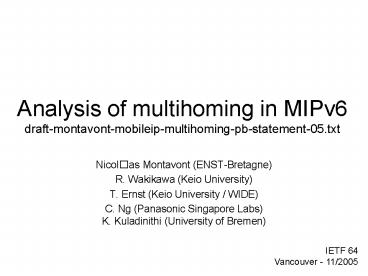Analysis of multihoming in MIPv6 draftmontavontmobileipmultihomingpbstatement05'txt - PowerPoint PPT Presentation
1 / 10
Title:
Analysis of multihoming in MIPv6 draftmontavontmobileipmultihomingpbstatement05'txt
Description:
Analysis of multihoming in MIPv6. draft-montavont-mobileip-multihoming-pb-statement-05.txt. Nicol*as Montavont (ENST-Bretagne) R. Wakikawa (Keio University) ... – PowerPoint PPT presentation
Number of Views:30
Avg rating:3.0/5.0
Title: Analysis of multihoming in MIPv6 draftmontavontmobileipmultihomingpbstatement05'txt
1
Analysis of multihoming in MIPv6draft-montavont-m
obileip-multihoming-pb-statement-05.txt
- Nicolas Montavont (ENST-Bretagne)
- R. Wakikawa (Keio University)
- T. Ernst (Keio University / WIDE)
- C. Ng (Panasonic Singapore Labs)
K. Kuladinithi (University of
Bremen)
IETF 64 Vancouver - 11/2005
2
Structure of the draft
- Multihoming / MIP6 related terminology
- Requirements
- Taxonomy
- Scenarios
- Issues
- IPv6 related issues
- MIPv6 related issues
- Implementation related issues
- Annex Why flow redirection is needed?
3
Terminology
- Definition of a multihomed MIP6 node
- In 3, a node is said to be multihomed when it
has multiple IPv6 addresses, either because
multiple prefixes are advertised on the link(s)
the node is attached to, or because the node has
multiple interfaces (see the entire definition).
For a mobile node operating MIPv6, this may
translate into the following definition - A MN operating MIPv6 is said multihomed
when it simultaneously has (i) multiple HoAs
(ii) multiple CoAs and/or (iii) one HoA and one
CoA configured on different interfaces. A MN may
have multiple HoAs/CoAs in the following cases - A MN would have multiple HoAs if multiple
prefixes are available on the home link or if it
has multiple interfaces named on (presumably)
distinct home links. - A MN would have multiple CoAs if multiple
prefixes are available on the foreign link or if
it has multiple interfaces attached to
(presumably) distinct foreign links.
4
Requirements
- Goals
- Permanent and Ubiquitous Access
- Reliability
- Load Sharing
- Load Balancing/Flow Distribution
- Preference Settings
- Aggregate Bandwidth
- End up with 8 requirements
- Note no performance issues are discussed
5
Taxonomy
- Changes
- From of interfaces, of HoAs, of CoAs
- To of HoAs, of CoAs
- End up with 5 cases
- (1,1)
- (1,n)
- (n,1)
- (n,n)
- (n,0) (no CoAs)
6
Issues
- General IPv6-related issues
- MIPv6 specific issues
- Considerations for MIPv6 implementation
7
General IPv6-related issues
- Path selection
- Separated into
- Interface selection
- HoA selection
- CoA selection
- Ingress filtering issues
- Failure detection issues
- On the MN/CN link
- On the path between the MN and the HA
- On the path between the HA and the CN
- On the path between the MN and the CN (RO)
8
MIPv6-specific issues
- Binding multiple CoAs to one HoA
- Binding a HoA as a CoA
- Simultaneous location in home and foreign networks
9
New sections
- Section 6.4 table which show which issues should
be considered in which scenario - Annex A Why a MN may want to redirect flows
- Failure detection
- New address
- Uninterrupted horizontal handover
- Change in network capabilities
- Initiation of a new flow
10
Next steps for the document
- Should we consider this draft as a WG document
for the following item - An analysis document explaining what are the
limitations for mobile hosts using multiple
simultaneous Care-of Addresses and Home Agent
addresses using Mobile IPv6, whether issues are
specific to Mobile IPv6 or not Informational.






























